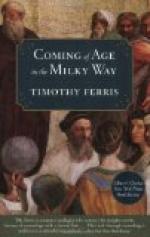|
This section contains 463 words (approx. 2 pages at 400 words per page) |

|
Chapter 8: Deep Space Summary and Analysis
Nebulae are fuzzy patches of glowing material that can be observed throughout the universe. Nebulae comprise three different classes of objects: gas thrown off by dying stars; clouds of gas illuminated by nearby stars; and, elliptical and spiral nebulae which are galaxies millions of light-years away. To understand the sun, it was necessary to learn the chemical make-up of stars. The first step in the exploration of intergalactic space was taken by philosopher Immanuel Kant and mathematician Johann Lambert and later by astronomer William Herschel.
Kant first became interested after reading a review of philosopher Thomas Wright's book, "An Original Theory or New Hypothesis of the Universe," which was most concerned with the location of God within the universe. The review distorted Wright's theories but led Kant to ultimately provide a glimpse of the universe of galaxies...
(read more from the Chapter 8: Deep Space Summary)
|
This section contains 463 words (approx. 2 pages at 400 words per page) |

|




